At its September 2017 meeting, the Federal Open Market Committee (FOMC) decided to leave interest rates unchanged, as was widely expected. The bigger news was that the Committee had decided to initiate its balance sheet normalization program in October 2017 so, in this blog piece, we plan to understand the unwinding of the Fed’s balance sheet and how it might impact markets, interest rates and financial institutions such as banks and credit unions.
Interest Rates Expected to Rise at December 2017 FOMC Meeting
Minutes from the FOMC September 2017 meeting state that “the Committee decided to maintain the target range for the federal funds rate at 1 to 1-1/4 percent”. This was in-line with our projections - in a blog titled Minutes, Market Data Suggest Fed Will Raise Rates in December 2017- where we predicted that, after the 25 basis point hike in June 2017, the Fed would next raise rates in December 2017 and no sooner. This prediction is further borne out by the Dot Plot from the FOMC’s September 2017 meeting which shows that 11 of 16 FOMC members expect the target range for the federal funds rate at 1.25 – 1.5 percent at the end of 2017, suggesting a strong likelihood of a 25-basis-point increase at the December 13-14, 2017, meeting.
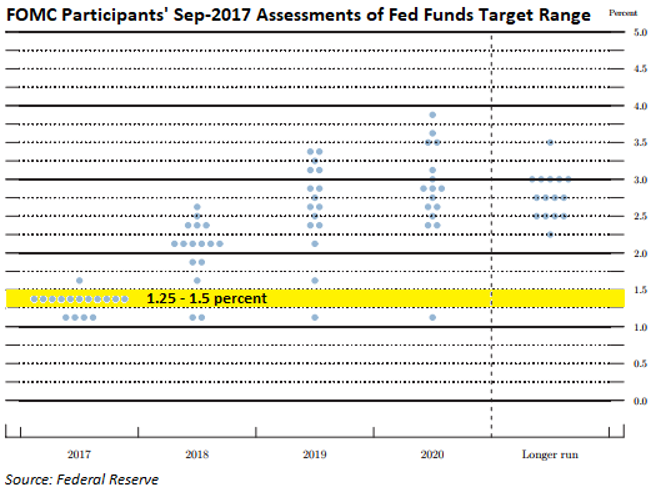
Expect Gradual Rate Hikes Over the Next Few Years
Moreover, in her press conference after the September 2017 FOMC meeting, Federal Reserve Chair Janet Yellen said that ongoing economic strength will “warrant gradual increases” in the fed funds rate to sustain a healthy labor market and stabilize inflation at the Fed’s 2 percent longer-run objective. Additionally, she said the rate is “somewhat below its neutral level that is neither expansionary nor contractionary” so the Fed will first bump up rates to attain a neutral level, followed by “additional gradual rate hikes over the next few years”.
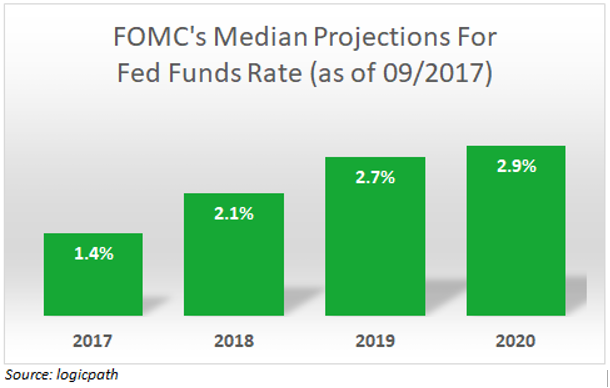
October 2017: Fed Begins Balance Sheet Normalization
The bigger story coming out of the Sep-2017 FOMC was the decision to begin the Fed’s balance sheet normalization program in October, with the Fed planning to “reduce its securities holdings in a gradual and predictable manner”.
Here’s some background: Before the recession hit in 2007, the Federal Reserve held $700 billion to $800 billion in Treasury notes as a normal and routine level of assets on its balance sheet. Then, when Fed policy makers felt the severity of the recession, they stepped in and initiated a Quantitative Easing (QE) program in late November 2008 - under which they spent about $3.7 trillion to buy government bonds, bank debt, mortgage backed securities and other financial assets from commercial banks and financial institutions - in order to stimulate the economy.
The idea was that buying massive amounts of financial assets would raise asset prices, lower their yields and keep interest rates low, reduce borrowing costs, increase money supply, and spur lending and investment that would help the economy recover more quickly from the Great Recession of 2007-09.
The Quantitative Easing program went through three major phases (QE1, QE2 and QE3) and was halted in October 2014, by which time the Fed had accumulated $4.5 trillion in assets.
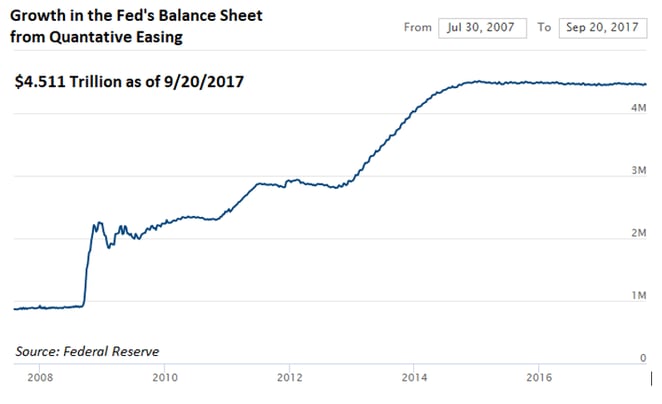
After quantitative easing was halted in October 2014, the Fed maintained the level of its assets at close to $4.5 trillion by reinvesting all proceeds from maturing securities (such as reinvesting principal from 2-year Treasury notes after they mature in 24 months) to buy new securities because the Fed wanted to plough cash back into the economy, sustain bond prices, maintain low interest rates and help the U.S. economy return to strength before it unwound its balance sheet.
September 2017 FOMC: Economy Strong Enough to Sustain Balance Sheet Reduction
At their September 2017 meeting, Fed policy makers were confident that the U.S. economy was on steady footing and expected it to expand at a “moderate pace over the next few years” – with solid job gains, low unemployment, moderate expansion in household spending, a pickup in business investment and 12-month inflation running below the Committee’s 2 percent target – and felt that a gradual unwinding of its balance sheet would not disrupt bond markets or hobble economic growth.
Fed Balance Sheet Reduction Plan: $10 Billion per Month, Gradually Ramping Up To A Maximum of $50 Billion per Month
Beginning in October 2017, the Fed started gradually decreasing reinvestments of proceeds from maturing securities - with the drop in holdings capped at $6 billion per month for Treasury securities and $4 billion per month for agency securities through December 2017. These caps will rise by $6 billion every quarter for Treasury securities (to a maximum of $30 billion per month) and by $4 billion every quarter for agency securities (to a maximum of $20 billion per month by Q4 2018), and will remain in place until the Fed’s balance sheet hits yet-to-be-defined normal asset levels.
In parallel, the Fed plans to gradually raise its Fed Funds target rate, provided the economy continues to hum along at an acceptable pace.
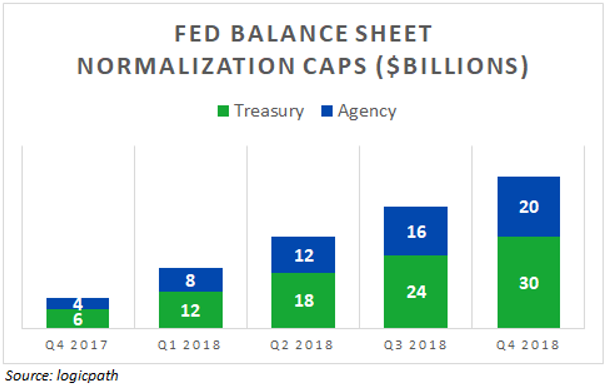
Fed Could Reduce Holdings By Up To $1.65 Trillion Through 2020
Accordingly, the Fed plans to reduce its holdings by $10 billion every month, for a total reduction of $30 billion over the October-December quarter, ramping up to maximum monthly reductions of $50 billion beginning October 2018 – for a maximum total reduction of $1.65 trillion through the end of 2020.
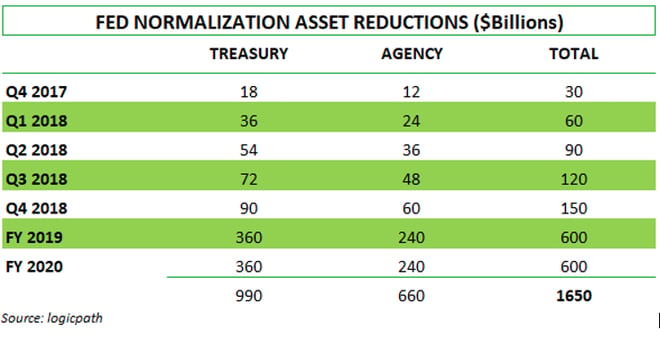
Yellen further said that the Fed would be open to slowing or reversing course but it would take “a material deterioration” in the economy’s performance for the Fed to reverse a schedule that she expects to implement “gradually and predictably”.
How Might This Impact Community Banks and Credit Unions?
|
Optimistic Scenario |
As the Fed reduces its reinvestments, Treasury and agency securities markets will be deprived of a highly-reliable, high-volume buyer. Consequently, other buyers – such as banks, credit unions and investment funds – will have to step-in and buy these securities. And although the Fed hopes that gently increasing caps and limiting the volume of securities that other investors have to absorb, will guard against large moves in interest rates and other potential market strains, that optimistic scenario may not necessarily play out. |
|
Uncertainty with Yellen Term Expiring in February 2018 |
Markets are also wary about the continuity of existing Fed policy because Yellen’s term expires in February 2018 and, as of end September 2017, there were no indications on whether she’d be re-appointed or replaced. A change in guard could lead to more aggressive normalization and cause unexpected adverse consequences. |
|
Rates Will Almost Certainly Rise |
If new Treasury and agency securities have a hard time getting sold, issuers may have to lower prices to find willing buyers. With interest rates moving in the opposite direction of bond prices, price reductions will lead to higher interest rates on these securities and could impact the yield curve as a whole – possibly taking rates higher for loans and mortgages, and adversely impacting the housing market. So investors and financial institutions should expect a rise in interest rates and hope that it’s modest enough to not disrupt our economic well-being. |
|
Skeptics Fear The Worst
|
But skeptics abound, especially as the Fed tries to balance normalization with raising interest rates. In a less optimistic scenario which many on Wall Street see happening, new debt issuers may have to sharply drop prices, causing a spike in interest rates, spooking investors and borrowers, and disrupting markets and the economy. This scenario could punish financial institutions that had earlier stepped-in to buy securities but are now left holding bonds that have sharply dropped in value. |
|
Equities May Take a Hit |
According to the Fed’s own research, quantitative easing pumped money into the economy which boosted equity prices, lowered interest rates and weakened the foreign exchange value of the dollar. With normalization, analysts believe equity markets could see a dip even though news of normalization might already be priced in. |
With the Federal Reserve’s normalization program now a reality, FIs should keep careful watch over how the U.S. economy and markets react to normalization and interest rate hikes and continuity at the Fed with Yellen’s term expiring in February 2018, analyze new investments thoroughly and model their impacts on the bank’s liquidity and risk profile… or risk getting blind-sided.
